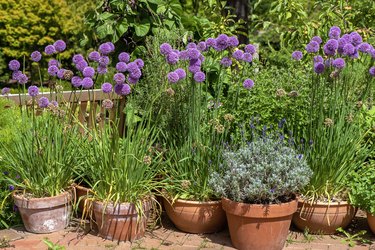
Many members of the Allium genus are more welcome in the kitchen than the flower garden: Think onions, garlic, and shallots. But other alliums — sometimes termed ornamental onions — are beautiful annuals and perennials that offer delightful puff-ball-type flowers atop tall, slender stems. Easy-care bulb plants, alliums require minimal maintenance, but deadheading can prolong the flowering period.
Meet the Ornamental Onion
Video of the Day
Think of ornamental onions (Allium spp.) as the pretty members of the onion family. They are bulb plants producing globe-shaped blossoms atop long, bare flowering stalks called scapes. The flowers are "umbels" composed of a cluster of florets. There are many varieties of ornamental onions in a variety of shades, most in the pink-lavender-blue spectrum. Some flowers are small, but others can reach 8 inches in diameter atop a 3- to 4-foot scape. When the scapes are taller than the nearby vegetation, it creates the impression that the flowers are hovering in thin air.
Video of the Day
Most alliums are bulb forming, which allows them to overwinter and return the next year in U.S. Department of Agriculture plant hardiness zone 4 and above. Some grow from rhizomes. In general, the plants grow quickly to bloom in the spring or early summer. But you can also find varieties that flower later in the season.
Care for Your Alliums
Although they offer intricate flowers in beautiful shades, ornamental onions are not prima donnas. Alliums require only minimal maintenance to thrive, and most involves appropriate siting. Plant your ornamental onion bulbs in a sunny location where they can get at least six hours of direct sun every day.
As for soil, alliums are not particular as long as they get excellent drainage. They are fine in clay, loam, or sandy soil. To extend the life of the flowers, you may want to deadhead the plants.
Deadhead Your Alliums
Do you need to prune ornamental onions? The only pruning to even consider is deadheading. This involves snipping off the flower heads as they wilt, before the plant produces seeds. In the case of the allium umbels, wait until most of the tiny flowers on each round inflorescence start to shrivel; then just "off with their heads." Use clean, sharp garden pruners to snip it off the flower stalk at the base.
Why deadhead allium? It isn't required or at all essential for the health of the plant. Further, deadheading will not cause a bulb plant to reflower later in the season either, despite what you read on the internet. Rather, some gardeners find it more aesthetically pleasing to remove the dead flowers (while others love them and leave them in place.) Deadheading does stop the plant from putting energy into seeding and prevents self-seeding.